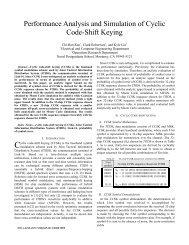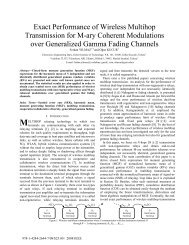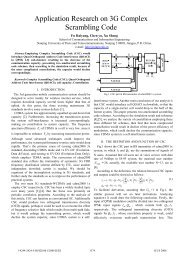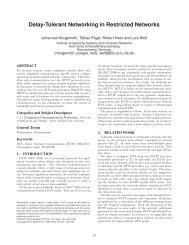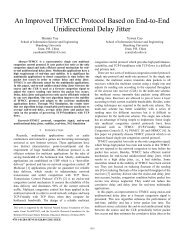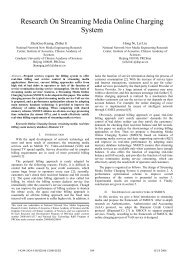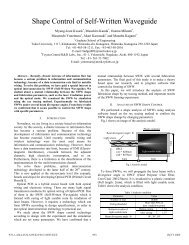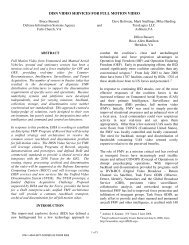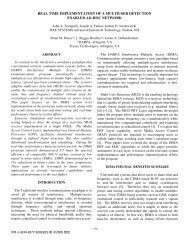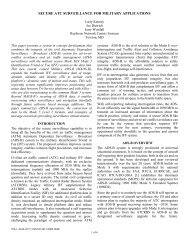Practical Implementation of PN Scrambler for PAPR Reduction
Practical Implementation of PN Scrambler for PAPR Reduction
Practical Implementation of PN Scrambler for PAPR Reduction
You also want an ePaper? Increase the reach of your titles
YUMPU automatically turns print PDFs into web optimized ePapers that Google loves.
After evaluating the derivative with respect to k, the joint<br />
PDF is given as<br />
f<br />
W , k<br />
( L,<br />
N,<br />
k)<br />
N<br />
N<br />
⎛<br />
L ⎞ ⎛<br />
L ⎞<br />
⎜ ⎛ ⎛ ⎞⎞<br />
⎜ ⎛ ⎛ ⎞⎞<br />
− ln 1−<br />
⎜1−<br />
exp⎜−<br />
⎟⎟<br />
⎟ ⋅ 1−<br />
⎜1−<br />
exp⎜−<br />
⎟⎟<br />
⎟<br />
2<br />
⎜<br />
⎟ ⎜<br />
⎟<br />
⎝ ⎝ ⎝ 2 ⋅σ<br />
⎠⎠<br />
⎠ ⎝ ⎝ ⎝ 2 ⋅σ<br />
⎠⎠<br />
⎠<br />
= 2<br />
The probability in (31) can now be found by integrating<br />
the joint PDF over the range <strong>of</strong> k,<br />
( L,<br />
N,<br />
k)<br />
dk = p<br />
k<br />
(33)<br />
k m<br />
k > = − ∫ f<br />
=<br />
Pr( 256)<br />
1<br />
(34)<br />
W , k<br />
k =0<br />
Equation 34 can be solved <strong>for</strong> L to obtain<br />
⎛<br />
⎜ ⎛<br />
L = − ln⎜1<br />
− ⎜<br />
1−<br />
p<br />
⎜ ⎝<br />
⎝<br />
1<br />
1 N<br />
m<br />
⎞<br />
⎟<br />
⎠<br />
⎞<br />
⎟<br />
⎟<br />
⎟<br />
⎠<br />
(35)<br />
Equation (35) can be used to find the required <strong>PAPR</strong><br />
threshold level L <strong>for</strong> any FFT size N. The value m in (35)<br />
is the desired number <strong>of</strong> k-<strong>PN</strong> scrambling sequences not to<br />
exceed. The value p in (35) specifies the probability that a<br />
given OFDM symbol will not require more than m<br />
scrambling sequences in order to pass the objective <strong>PAPR</strong><br />
threshold level setting L. Evaluating (35) using p=10 -4 ,<br />
m=256, and N=64 yields the required <strong>PAPR</strong> threshold<br />
level setting L=2.98 or 4.74 dB.<br />
In order to find the average number <strong>of</strong> scrambling<br />
sequences, it is convenient to make use <strong>of</strong> the definition <strong>of</strong><br />
the expected value <strong>of</strong> a random variable,<br />
∞<br />
∫<br />
−∞<br />
X = E[<br />
X ] = x ⋅ f ( x)<br />
dx<br />
(36)<br />
The average number <strong>of</strong> scrambling sequences k becomes<br />
= ∞<br />
∫<br />
=<br />
⎟ ⎟⎟<br />
k ⎛<br />
N<br />
N<br />
k ⎞<br />
⎜ ⎛<br />
⎞ ⎛<br />
⎞<br />
⎜ ⎛ ⎛ L ⎞⎞<br />
⎟ ⎜ ⎛ ⎛ L ⎞⎞<br />
(37)<br />
k = k ⋅<br />
⎟<br />
⎜−<br />
ln 1−<br />
⎜1−<br />
exp⎜−<br />
⎟⎟<br />
⋅ 1−<br />
⎜1−<br />
exp⎜−<br />
⎟⎟<br />
dk<br />
2<br />
2<br />
⎜ ⎜<br />
⎟ ⎜<br />
⎟<br />
⎝ ⎝ ⎝ ⎝ 2⋅σ<br />
⎠⎠<br />
⎠ ⎝ ⎝ ⎝ 2⋅σ<br />
k 0<br />
⎠⎠<br />
⎠ ⎠<br />
After simplification,<br />
−1<br />
(38)<br />
k =<br />
N<br />
⎛<br />
⎞<br />
⎜ ⎛ ⎛ L ⎞⎞<br />
ln 1−<br />
⎜1−<br />
exp⎜<br />
− ⎟⎟<br />
⎟<br />
⎜<br />
2 ⎟<br />
⎝ ⎝ ⎝ 2⋅σ<br />
⎠⎠<br />
⎠<br />
For this example, the average number <strong>of</strong> <strong>PN</strong> scrambling<br />
sequences that will occur at this <strong>PAPR</strong> threshold level<br />
setting is<br />
( ( ( ) ) ) 27.8<br />
1<br />
64<br />
ln 1 1 exp 2.<br />
98<br />
=<br />
−<br />
k =<br />
(39)<br />
− − −<br />
Using 64-QAM modulation per subcarrier, the<br />
overhead v <strong>for</strong> this example is<br />
log 2 ( m)<br />
log ( 256)<br />
(40)<br />
2<br />
v =<br />
= = 0.<br />
028<br />
N ⋅ N ⋅ C 3<br />
bps 64 ⋅ 6 ⋅<br />
4<br />
where m is the number <strong>of</strong> sequences not to exceed, N is the<br />
number <strong>of</strong> subcarriers, Nbps is the number <strong>of</strong> bits per<br />
subcarrier based on the constellation size, and C is the<br />
FEC code rate.<br />
6 <strong>of</strong> 7<br />
In summary, in order to ensure that the OFDM<br />
transmitter does not exceed k=256 <strong>PN</strong> scrambling<br />
sequences with a probability <strong>of</strong> p=10 -4 , the peak power<br />
threshold level must be set to L=4.74 dB which will<br />
require approximately k=28 <strong>PN</strong> scrambling sequences on<br />
average. In other words, the system will have a <strong>PAPR</strong> less<br />
than or equal to 4.74 dB with a 99.9900% probability.<br />
Without the symbol scrambling (i.e. k=1), the <strong>PAPR</strong> is<br />
11.3 dB at p=10 -4 . Using the system parameters derived in<br />
this example, this technique results in an improvement <strong>of</strong><br />
6.5 dB with an insignificant overhead <strong>of</strong> 2.8%.<br />
4. PRACTICAL IMPLEMENTATION<br />
The <strong>PN</strong>-<strong>Scrambler</strong> was implemented as a <strong>PAPR</strong><br />
reduction technique <strong>for</strong> an IEEE 802.11a OFDM modem.<br />
Without application <strong>of</strong> the <strong>PAPR</strong> reduction, the CCDF<br />
curve <strong>for</strong> the IEEE 802.11a OFDM modem closely follows<br />
the k = 1 curve <strong>of</strong> Fig. 3, indicating that the IEEE 802.11a<br />
wave<strong>for</strong>m has a large <strong>PAPR</strong>.<br />
<strong>PAPR</strong> <strong>Reduction</strong> ON<br />
<strong>PAPR</strong> <strong>Reduction</strong> ON<br />
Back<strong>of</strong>f = 8 dB<br />
Back<strong>of</strong>f = 8 dB<br />
EVM = -40.34 dB<br />
EVM = -40.34 dB<br />
<strong>PAPR</strong> <strong>Reduction</strong> ON<br />
<strong>PAPR</strong> <strong>Reduction</strong> ON<br />
Back<strong>of</strong>f = 5 dB<br />
Back<strong>of</strong>f = 5 dB<br />
EVM = -33.44 dB<br />
EVM = -33.44 dB<br />
<strong>PAPR</strong> <strong>Reduction</strong> OFF<br />
<strong>PAPR</strong> <strong>Reduction</strong> OFF<br />
Back<strong>of</strong>f = 8 dB<br />
Back<strong>of</strong>f = 8 dB<br />
EVM = -34.35 dB<br />
EVM = -34.35 dB<br />
<strong>PAPR</strong> <strong>Reduction</strong> OFF<br />
<strong>PAPR</strong> <strong>Reduction</strong> OFF<br />
Back<strong>of</strong>f = 5 dB<br />
Back<strong>of</strong>f = 5 dB<br />
EVM = -25.40 dB<br />
EVM = -25.40 dB<br />
Figure 5. VSA EVM plots with and without<br />
<strong>PAPR</strong> reduction<br />
The OFDM signal from the output <strong>of</strong> the I/Q<br />
modulator was sent through a 10-Watt Stealth Microwave<br />
Class-A Power Amplifier (SM0825-40) into an Agilent<br />
Vector Signal Analyzer 89641A (VSA). The VSA<br />
demodulated the OFDM signal and the resulting<br />
constellations are shown in Fig. 5. The results show<br />
significant reduction in the Error Vector Magnitude<br />
(EVM) with <strong>PAPR</strong> reduction “on” versus with <strong>PAPR</strong><br />
reduction “<strong>of</strong>f.” Furthermore, the results show that at 8 dB<br />
back<strong>of</strong>f from the power amplifier’s one dB compression<br />
point (P1dB) with <strong>PAPR</strong> reduction turned-<strong>of</strong>f produces<br />
approximately the same EVM as 5 dB back<strong>of</strong>f when the<br />
<strong>PAPR</strong> reduction is turned-on. This 3 dB reduction in<br />
back<strong>of</strong>f provides twice the RF output transmit power, or<br />
equivalently, allows a 10-Watt amplifier to be used instead<br />
<strong>of</strong> a 20-Watt amplifier.



